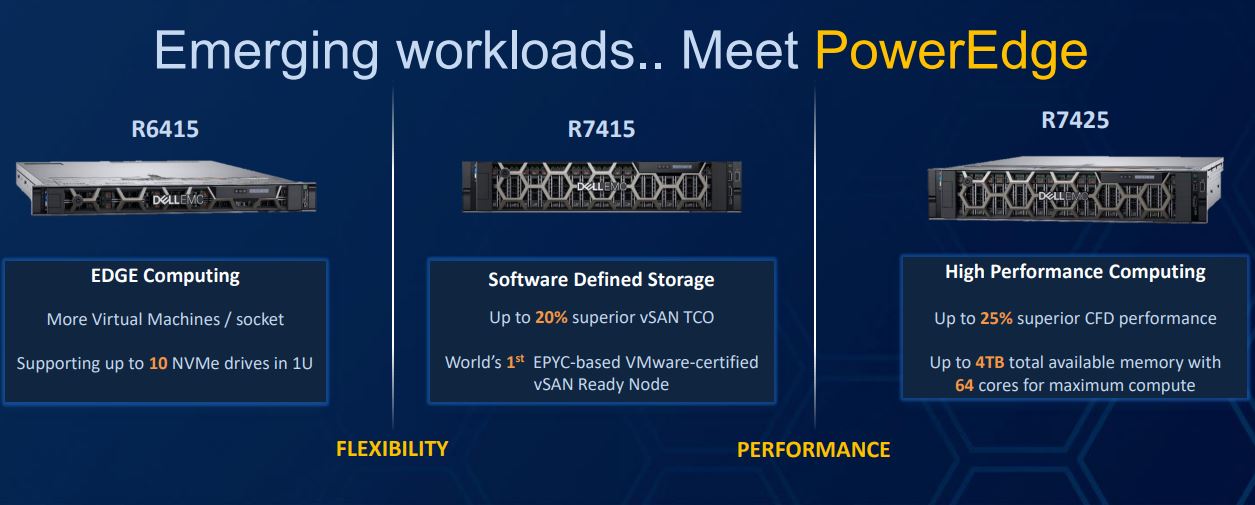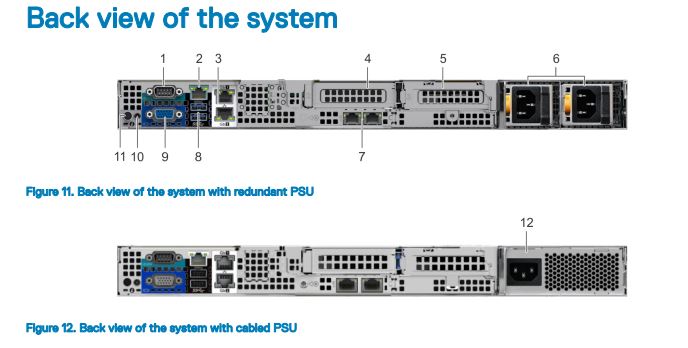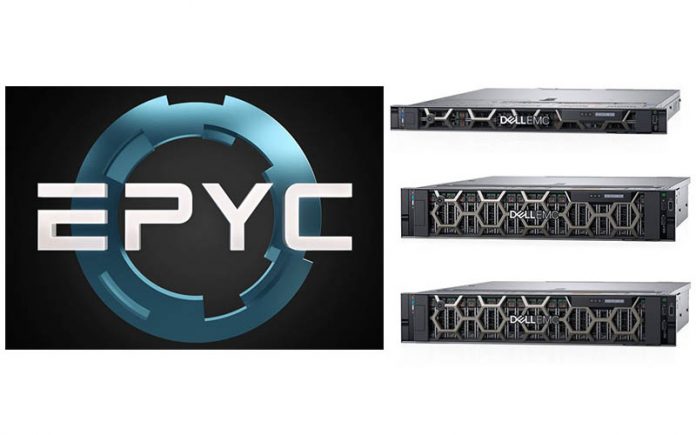Dell EMC and AMD are lucky. We agreed to an embargo on the news and were briefed by the joint teams on today’s announcement only a few hours before we spotted the servers on the loading dock for one of Dell EMC’s early access customers. This is huge news that we have been waiting to share, AMD EPYC powered Dell EMC PowerEdge servers are here.
It has been about 6 years since we have seen a PowerEdge based on AMD, that is quite a gap. The Intel Xeon E5 introduction absolutely crushed AMD’s architecture at the time. Fast forward to today and AMD is back with EPYC. At STH, we have done a ton of content around AMD EPYC, and we are about to take the next step. We plan to add AMD EPYC into the main STH hosting cluster over the next few months. Not only can we recommend EPYC, but we are using it daily.
The Dell EMC PowerEdge announcement is a big deal. Recently, Dell Technologies took over the #1 spot in both revenues and units sold. As HPE has been selling off businesses, Dell Technologies is rapidly expanding. While HPE offered a Cloudline server (not for its mainstream customers) and a DL385 2P 2U server, HPE’s offerings thus far have been limited. Not only is PowerEdge offering a dual processor 2U server, like HPE, but Dell EMC is offering something special. At introduction, the Dell EMC PowerEdge lines will have two single-socket 1U and 2U systems. Part of AMD’s value proposition is that one can replace two Intel Xeon CPUs with one AMD EPYC. Dell EMC is firmly standing behind this concept and showing why it is so powerful.
AMD EPYC Powered Dell EMC PowerEdge Family Overview
There are three new servers in the AMD EPYC powered Dell EMC PowerEdge family. The Dell EMC PowerEdge R6415 is a 1U single socket offering somewhat akin to the Dell EMC PowerEdge R640 server we reviewed. The PowerEdge R7415 is a 2U single-socket server that is a truly unique offering today. In a more traditional 2U dual socket form factor is the PowerEdge R7425.
All of the AMD EPYC PowerEdge servers we are told have the company’s class-leading iDRAC and open manage management features down to Quick Sync 2 which allows one to use mobile devices to configure servers. This means that these three new servers can be seamlessly integrated into existing Dell EMC PowerEdge shops without changing management tools or the need to train staff on new standards.

We will be testing the claims that the management experience is the same in the near future when we get one of these systems in our lab.
If you want to read more about AMD EPYC versus Intel Xeon Scalable, check out our AMD EPYC and Intel Xeon Scalable Architecture Ultimate Deep Dive piece.
Dell EMC PowerEdge R6415
In the traditional 1U form factor, the Dell EMC PowerEdge R6415 takes advantage of the expansive AMD EPYC PCIe connectivity. On the Intel side, it is aimed squarely as an alternative to the Dell EMC PowerEdge R640 that we reviewed. The AMD version uses one CPU instead of two. Even using a single CPU, AMD’s 128 high speed I/O lanes with a single socket design means it can light all ten 2.5″ bays with NVMe storage.

Given the 1U nature of this machine, it has some interesting features. According to the tech specs, there are 8x 2.5″ front bay and 4x 3.5″ drive bay options as we see with the PowerEdge R640. At the rear of the unit, one can see dual low profile expansion slots, a network LOM option and either single or redundant PSUs.
Dell EMC PowerEdge R7415
One of the more intriguing options is the Dell EMC PowerEdge R7415 which is a 2U single socket server. Even with a single socket, the PowerEdge R7415 supports up to the 32 core / 64 thread AMD EPYC 7601 CPU and up to 1TB of RAM (16x 64GB LRDIMMs). In terms of drives, the PowerEdge R7415 system supports:
- Up to 8 x 3.5 inch (SAS, SATA or Nearline SAS) front accessible drives in slots 0 to 7
or - Up to 12 x 3.5 inch (SAS, SATA or Nearline SAS) front accessible drives in slots 0 to 11
or - Up to 12 x 3.5 inch (SAS, SATA or Nearline SAS) front accessible drives in slots 0 to 11 + up to 2 x 3.5 inch (SAS, SATA or Nearline SAS) rear accessible drives in slots 12 to 13
or - Up to 24 x 2.5 inch (SAS, SATA or Nearline SAS) front accessible drives in slots 0 to 23
or - Up to 12 x 2.5 inch (SAS, SATA or Nearline SAS) front accessible drives in slots 0 to 11 and up to 12 x 2.5 inch NVMe drives in 12 universal slots 12 to 23
The CPU core counts, RAM capacities, and storage configurations are what give this unit its edge. Dell EMC claims a 20% better vSAN TCO over Intel-based configurations. This is partly due to extraordinarily aggressive single socket pricing by AMD and its “P” series CPUs designed specifically for servers like the Dell EMC PowerEdge R7415. The second major cost savings comes from license cost savings of having one CPU versus two. The PowerEdge R7415 is the first VMware certified vSAN ready node. Dell Technologies is leveraging its ecosystem to assure customers that they can deploy the new servers and reap benefits.
Packet, a cloud provider that hosts projects such as Ubuntu, is one of Dell EMC and AMD’s launch customers for the new server line. We confirmed that Packet is using the Dell EMC PowerEdge R7415 with AMD EPYC 7401P 24 core / 48 thread CPUs. We reviewed the AMD EPYC 7401P and found it to be an astounding value.
Dell EMC PowerEdge R7425
For a more traditional dual socket configuration, the Dell EMC PowerEdge R7425 is a 2U dual EPYC capable server. One can use up to 2x 32 core CPUs and fit up to 2TB of RAM using 32x 64GB quad-rank DDR4 LRDIMMs. For drive configurations, the Dell EMC PowerEdge 7425 supports up to 32 drives in a single 2U system. Here are the available configurations:

Update: In the original tech specs there was a note saying that the system did not support NVMe hot swap. Upon the system’s release, Dell EMC confirmed that in updated tech specs NVMe hot swap is supported. This is a big step for AMD EPYC.
At the end of the day, the Dell EMC PowerEdge R7425 gives companies looking to diversify their infrastructure from Intel an x86 compatible alternative. It also allows a company to add more cores and more RAM per socket than mainstream “non-M” Intel parts. That can help lower costs in a per-socket licensing regime.
New Naming Convention
A quick note on the naming convention. Dell EMC’s mainstream PowerEdge server designations are generally three digits such as the T640, R740 and etc. These AMD servers use a four-digit naming convention. Here is a way to read them using the R6415:
- R is for rackmount
- 6 is for the 6 family of 1U servers
- 4 is the generation designation
- 1 is for single CPU
- 5 is for AMD
That fourth character is essentially added for the AMD EPYC systems to designate single or dual socket platforms. That tells us about the difference between the R7415 (single socket) and R7425 (dual socket.)
Final Words
Reading between the lines, the significance of this release cannot be understated. Dell EMC has a massive sales and distribution network that AMD now has access to. This announcement also vindicates a storyline AMD and STH have been offering: that EPYC single socket performance can be a huge benefit. Dell EMC is touting the PowerEdge R7415 with a 20% VMware vSAN TCO savings. A lot of that savings is happening at the expense of another Dell Technologies family company, VMware.
While many of the early AMD EPYC server offerings targeted hyper-scale style deployments, Dell EMC has the software, service and support infrastructure to bring AMD EPYC into traditional enterprises. In doing so, AMD has found a major partner. Likewise, Dell EMC’s expanded portfolio shows why it is the go-to server company for enterprises and why it is aggressively gaining share from competitors.
The new servers are available to order today and will ship in accordance with Dell EMC’s standard lead times. We have already seen a pallet of the R7415’s in a data center so these are tangible instead of vaporware. This is a big announcement for Dell EMC, AMD, and their customers.




